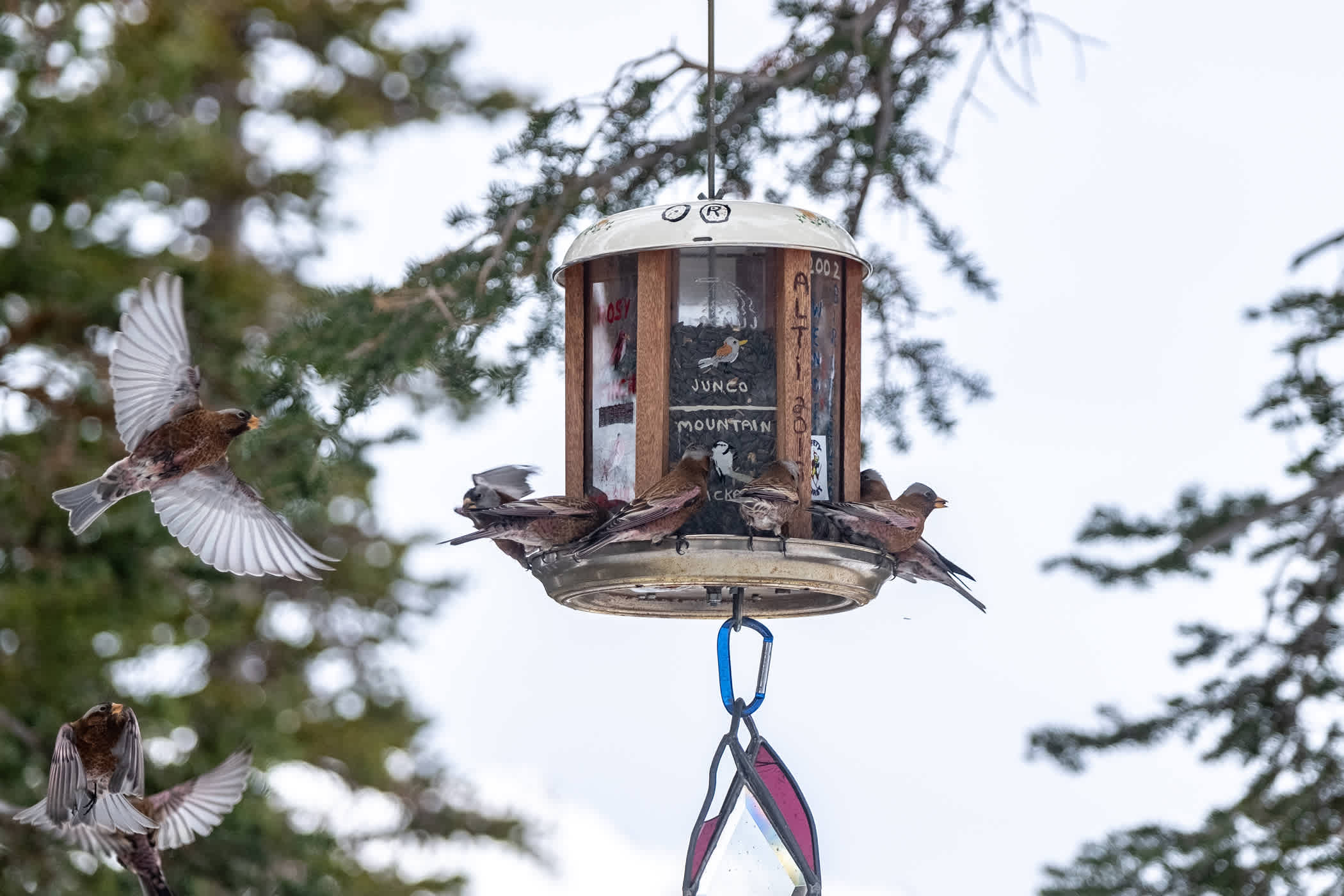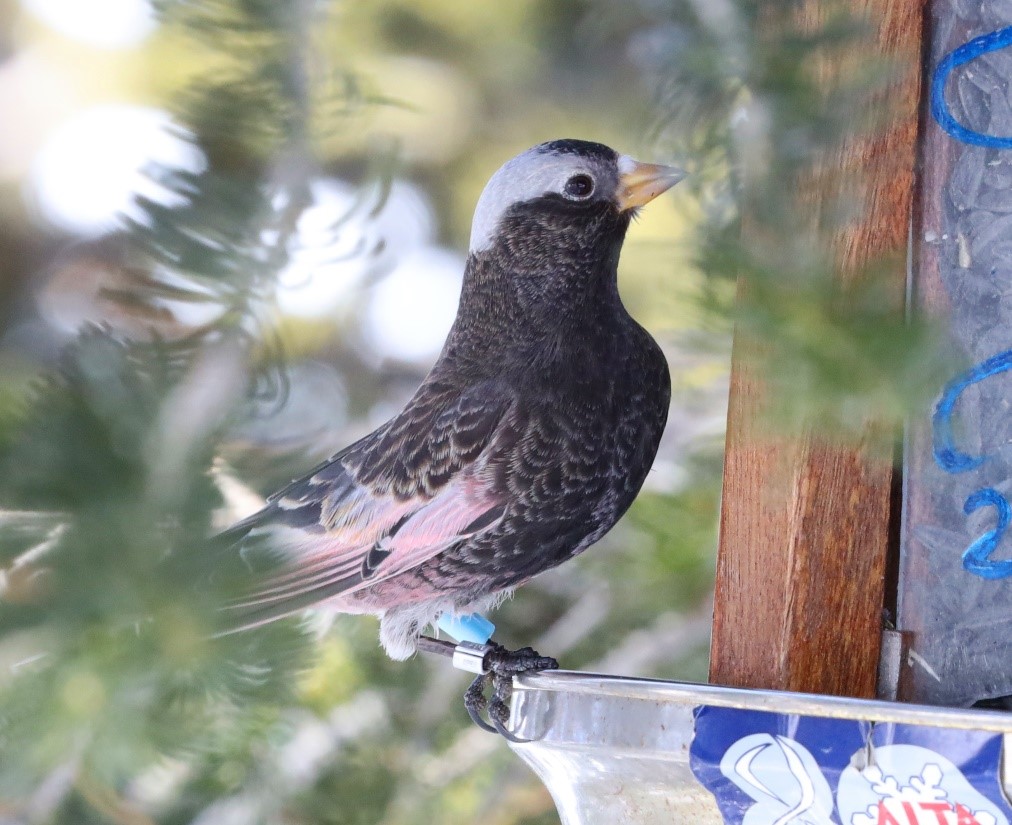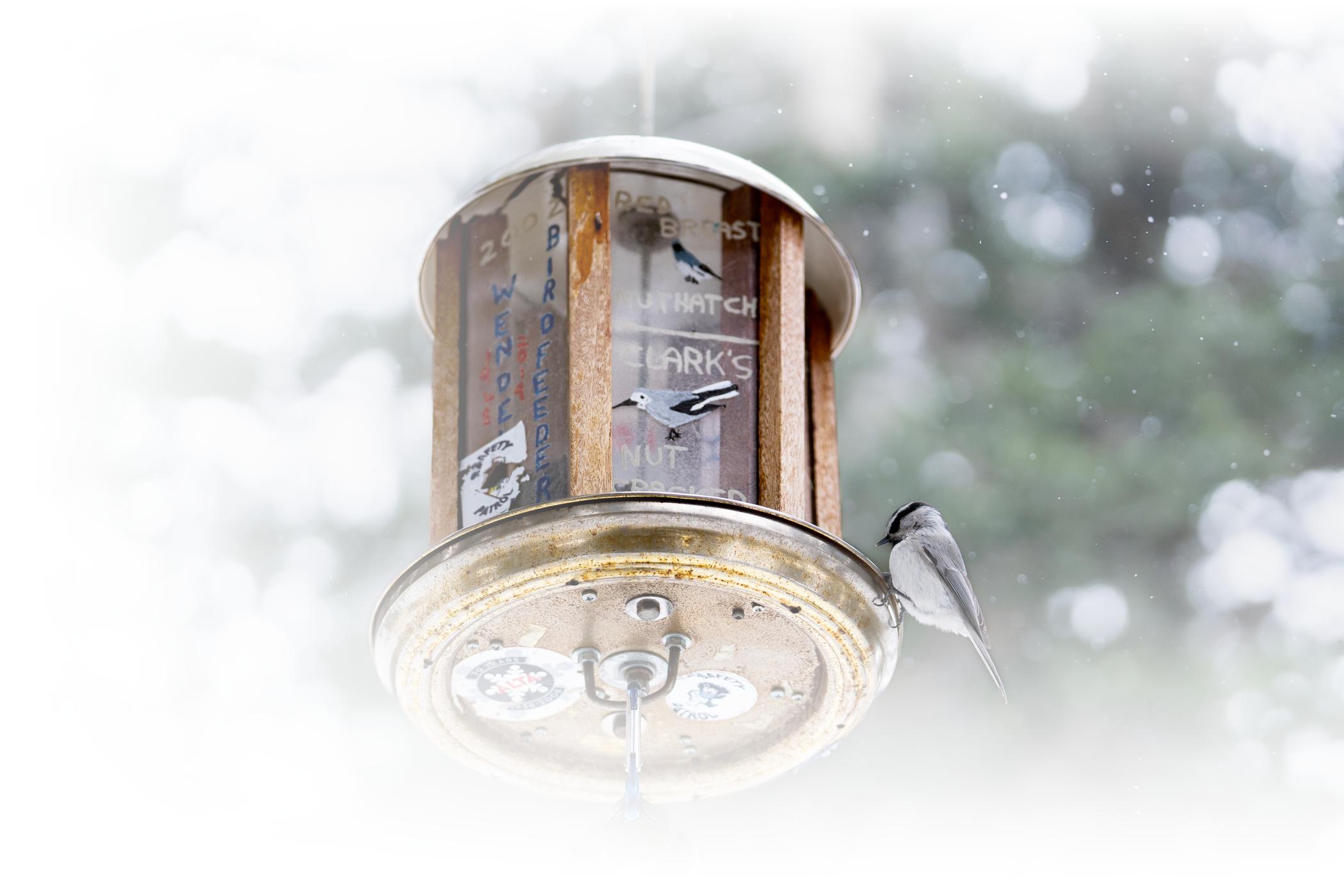It all started in the seventies with one skier—Wendell whiting.
Updated: February 2025
Words: Janice Gardner
It all began in the 70s with one bird-loving skier—Wendell Whiting. Wendell was the jack-of-all-trades—from tele-skier to artist—but his commitment to a sober lifestyle made connecting with nature a central part of his Alta experience. The first of many bird feeders at Alta was hidden among a cluster of subalpine fir and Engelmann spruce trees along the path where the old Germania chairlift once stood. Wendell was known for hauling pounds of black oil sunflower seeds on skis into this secluded spot. His efforts paid off, attracting Mountain Chickadees and Pine Siskins, sparking a unique birding culture at Alta.
Throughout the 1980s, more feeders appeared around the mountain, quietly placed there by individuals whose identities remain a mystery.
Tyler Peterson’s first memory of visiting one of Alta’s bird feeders was on skis with his dad and Wendell. At that time, the feeders had code names—the one they visited is now known as "Wendell's Feeder." Wendell took the opportunity to explain the difference between Utah’s two species of Chickadees—Mountain and Black-capped—which marked Tyler’s first lesson in bird identification. Since then, he has become an avid birder and has established his own feeders at Alta and Snowbird.

By the mid-90s, Alta's management had become involved in the birding community. One day, at the top of the mountain, a man with little skiing experience, equipped with binoculars and a camera, asked Ski Patrol Director Gus "Piney" Gilman about the best places to see birds. Piney, who was also a self-registered birder, kindly guided the birdwatcher-turned-skier down the mountain, stopping at feeders along the way—and likely helping the man avoid the need for a rescue toboggan.
Gilman recalls, “When I told Onno Wieringa [Alta’s General Manager at the time] that people were buying a day lift ticket and renting skis just to take one ski run to see birds, that was something special.” As a result, birdseed was added to the ski patrol’s equipment budget to support the popular Collins lift feeder—which remains included in the patrol's budget today.
If you’ve skied Alta, you know there are bird feeders hidden across the mountain. So, what keeps these feeders from going dry? Alta Magic.
Several bird seed stockers are involved, including Paul “Pablo” Lippert. Ever since Paul met Wendell decades ago, he has ensured that the feeders are always full of seeds for the chirping winter birds. In the lift line, strangers often hand him five- and ten-dollar bills to contribute to the collection basket designated for birdseed.

In the 2019 season, Paul used 280 pounds of seed to fill Alta’s bird feeders. He also builds custom feeders designed to withstand harsh winter storms, crafting them from odd parts taken from lamps and kitchen appliances that he finds at thrift stores. However, the fact that the feeders are consistently full across the slopes suggests that many others are also involved. We may never know exactly which skiers sneak ziplock bags of birdseed into their ski jackets, glide across the mountain and stuff their favorite feeders with fresh seeds.
The Rosy-finches
Alta’s bird feeders attract around a dozen species during the winter. For Piney, the main draw of the feeders is his favorite bird, the Clark’s Nutcracker. This large bird, is patterned in gray, black and white and is known for its loud croaks and raspy calls.
Vivian Schneggenburger finds the vast flocks of Gray-crowned and Black Rosy-Finches to be the most exciting part of the winter scene. She is not alone in her appreciation for Rosy-Finches, which are rare birds that attract special attention from many observers.


Photo Credit: Rocko Mencyk and Janice Gardner
The Rosy-Finch is somewhat like the locals of Alta—they love the mountains, thrive during snowstorms, and can be quite nomadic in their seasonal travels. As their name suggests, these sparrow-sized birds have pink feathers on their flanks and wings. This is particularly remarkable, as very few birds in nature display pink feathers, aside from flamingos.
The Least understood birds in North America are right here at Alta
These birds are unique and incredibly difficult to spot in the wild. There are three species of Rosy-Finch—and birders often seek to see at least one. To observe a Gray-crowned Rosy-Finch during the summer, birders must travel to the high tundra of Alaska and the Yukon Territory. The Black Rosy-Finch and the Brown-capped Rosy-Finch raise their young in the Rocky Mountains, but spotting them requires climbing talus cliffs at the highest mountain peaks.
In winter, Rosy Finches often form large flocks and move across vast, uninhabited plateaus and canyonlands. Only a handful of birders and scientists have discovered a rosy finch nest, and locating their nomadic flocks during winter can be challenging. Due to their rugged habitats and elusive nature, Rosy-Finches—especially the Black Rosy-Finch—are among the least understood birds in North America.
Populations of the Rosy-Finch may be declining—leading to recognition as a conservation concern by the U.S. Fish and Wildlife Service, the Utah Division of Wildlife Resources and the U.S. Forest Service. Interestingly, Alta is one of the rare locations where Rosy-Finches can be easily spotted!
 Rosy-Finches at the top of Collins bird feeder
Rosy-Finches at the top of Collins bird feeder
Rosy-Finches rely on high-elevation alpine habitats, such as the snow-covered slopes of Alta. However, climate change is rapidly shrinking these environments, raising concerns among scientists. Additionally, there is a lack of information regarding these birds' population size, distribution, and resource needs to raise their chicks successfully. Without this essential knowledge, it becomes difficult to determine how to help these birds adapt to the impacts of climate change.
Learn more about Rosy-Finches at Alta >
Our citizen scientists

In 2018, biologists from government agencies and non-profit conservation organizations came together with a shared determination to ensure that Rosy-Finches would not disappear before we could understand how to protect them. To uncover the secrets of these birds, they needed to study them up close.
The biologists found a suitable location for the rosy-finch project in Alta, where the local birding community had already fostered a strong awareness of these birds. This collaboration involved the Alta Ski Area, Friends of Alta, and the U.S. Forest Service, which helped create a supportive environment for the researchers. Thus, the Rosy-Finch Project was established.
The project has two main pillars: the innovative use of RFID technology and bird surveys conducted by community scientists in Alta and across the western United States. This combination enables biologists to study Rosy-Finches highly efficiently and effectively.
Partnerships forming throughout the state and region are primarily due to the success supported by the Alta community.
Learn more about the Rosy-Finch Project >
Photo Credit: Janice Gardner
The conservation legacy
Wendell passed away in 2019. During his memorial, his friends and family distributed pouches of birdseed in his honor. They paid tribute to him at “Wendell’s Feeder,” a spot nestled among conifers that has been accessible from the Collins lift for decades. The feeder is adorned with stained-glass ornaments he crafted and features hand-drawn birds that are lovingly maintained. This bird feeder is a testament to Wendell’s passion for birds and the vibrant bird-watching culture he inspired within the ski community. Furthermore, it symbolizes what a community can achieve in conserving a small bird species and an entire ecosystem.
You can also get involved in rosy-finch conservation in your area! Join the Wild Utah Project and the Tracy Aviary, who are seeking volunteers to assist with bird surveys during the 2020-2021 season.
Alta's Infamous Bird Feeders
Bird feeders around the mountain offer a unique way to experience Alta’s excellent birdwatching firsthand. But remember, they are also the homes of our feathered friends. We encourage you to explore the mountain in search of these magical spots while respecting their habitat.
These feeders are part of a community effort to support native wildlife and are intentionally placed in quiet, undisturbed areas. To minimize traffic and protect these sanctuaries, we don’t share exact locations. However, many of them are nestled among the trees in the Sunnyside, Sugarloaf and Collins areas—so keep an eye out!
Feeder Access & Etiquette:
- During winter, all feeders within the ski area are only accessible by skiing. Uphill travel of any kind is prohibited within Alta Ski Area during the operating season.
- Looking for an alternative spot? Some homes along Summer Road have personal feeders that are occasionally filled. Uphill travel is permitted in this area, making it a great birdwatching destination for backcountry skiers, those on foot, or those on snowshoes.
- Not a skier? Feeders become more accessible in the off-season, allowing for easier exploration when skiing isn’t required.
Wherever you go, enjoy the adventure, respect the wildlife and take in the beauty of Alta’s birds in their natural habitat.

Add Your Comment